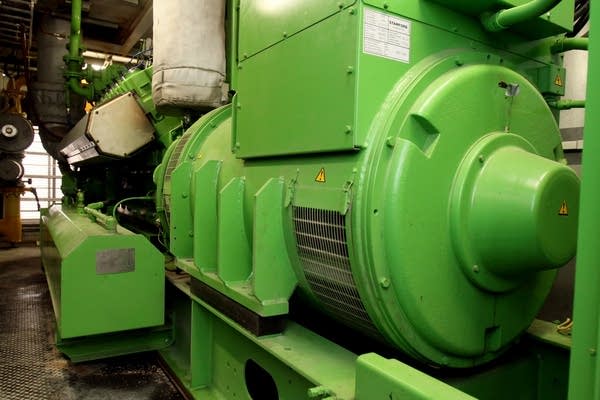Wisconsin hospital's renewable energy push brings the green

Go Deeper.
Create an account or log in to save stories.
Like this?
Thanks for liking this story! We have added it to a list of your favorite stories.
The semitrailer backing up to the Gundersen Health System building is packed with material vital to the hospital's success. But these aren't medical supplies. They're wood chips.
After some maneuvering, the driver unlocks the truck's back doors and thousands of 2-inch wood chips from six mills around western Wisconsin, southeast Minnesota and northeast Iowa pour into a giant concrete pit. When full, the pit holds 75 tons of wood.

As the sweet smells of freshly cut birch, oak and maple fill the air, Jeff Rich, the hospital's point man on renewable energy, explains what drove Gundersen to become the nation's first energy independent hospital.

"We save about $500,000 a year on this project and reduce electricity costs and heating benefit," he says of the wood-powered boiler that generates steam to heat buildings, dehumidify air and sanitize medical equipment, as well as electricity to power the downtown La Crosse clinic.
Turn Up Your Support
MPR News helps you turn down the noise and build shared understanding. Turn up your support for this public resource and keep trusted journalism accessible to all.
"We purchase now about $800,000 worth of wood chips that in the past would have been $1.2, $1.4 million worth of natural gas coming from other states or other nations. So we're helping the economy of our region by keeping those dollars local."
Many hospitals around the country are looking at ways to reduce costs and stay competitive. But Gundersen officials have gone all-in on making the health system independent of conventional, industrial energy sources.
The wood chips that feed a massive boiler are part of nearly a dozen renewable projects Gundersen officials have implemented in the last few years. Now, Gundersen officials want to teach their early lessons to other medical facilities across the country.
"Hospitals' expense on energy is about 1 percent. That's why so many don't focus on it," said Rich, executive director of Envision, Gundersen's for-profit energy consulting arm. "Yet, it's a big opportunity. It's millions of dollars."

To save millions, the health system has had to spend millions.
It's spent about $40 million on projects ranging from two wind farms — one in Lewiston, Minn., the other in Cashton, Wis. — and a dairy digester that uses methane gas from cow manure to create electricity, to software upgrades that automatically shut off computers and new light fixtures throughout two different campuses.
Of that, $11 million came from local, state and federal grants and incentives, according to Rich.
Gundersen started looking in 2008 for alternative ways to meet its energy needs. Back then, its energy bill hovered around $5.3 million.
Last year, Gundersen spent about $5.1 million on energy costs, and that's including 26 percent more square footage with a new hospital. The system's total energy consumption also dropped 36 percent from 2008 to 2014 despite the added building space.
Rich estimates last year's electricity bill would have grown to about $8 million without the energy saving measures.
Gundersen's had some dark moments, too, on the road to energy independence.
A proposed energy reclamation project at a local brewery failed when cleaning the brewery's waste gas to generate electricity became too expensive. High costs also derailed a separate project involving a proposed hydrokinetic plant on the Mississippi River.
Still, there have been more successes than failures, enough so that Gundersen spun off Envision to teach classes and offer energy design help to other healthcare facilities. The consulting group brought in about $80,000 last year. Since 2009, it's worked with about 10 hospital systems, mostly in the Upper Midwest, according to Rich.
That includes ThedaCare, an Appleton, Wis.-based community health system. Gundersen officials helped the facility come up with a few dozen energy reduction ideas right away, said Paul Linzmeyer, ThedaCare's sustainability leader.
"The facilities people started realizing that we could really do this stuff," he said. "It's doable. It's not some impossible, abstract thing."
Linzmeyer says ThedaCare's goal now is energy independence by 2025.
Many hospitals across the country are interested. Gundersen, though, has made sustainability a part of the company's culture, said Jeff Brown, executive director of Practice Greenhealth, a healthcare sustainability group.
"Gundersen is unique in the energy independence area," he said. "There's no doubt about that. They've taken it much more seriously, been much more visionary about what was possible."
Once institutions see the scope of the potential savings and environmental benefits, it doesn't take a lot of convincing to sell them on the idea, Brown added.

Back at Gundersen's Onalaska campus, Jeff Rich walks toward the end of parking lot where a 16-cylinder engine sits inside a secure container. It's powered by biogas piped from the county landfill.
Gundersen sells the electricity back to the grid and also captures heat from the block to warm two nearby buildings.
"In fact, nine months of the year, we're having to exhaust heat off the radiator into the atmosphere because we can't use it," he said, adding that Gundersen's next project will be to try and harness that excess energy — to chill water.


